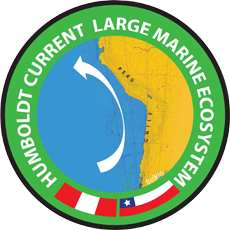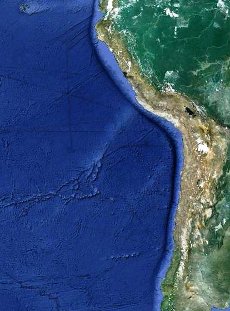Situation Analysis
The context and global significance
The Humboldt Current LME (HCLME) extends along the west coast of Chile and Peru, off western South America. It encompasses a complex mosaic of currents that support some of the most productive fisheries on earth and houses biodiversity (BD) of global importance. The relatively steady alongshore winds that blow towards the equator drive strong coastal upwelling from 40ºS up to 4ºS.
(1) A low-latitude situation that combines strong upwelling-based nutrient enrichment with low wind-induced turbulence generation and relatively extended mean ‘‘residence times” within the favorable upwelling-conditioned near-coastal habitat
(2) The cyclic ‘‘re-setting” of the system by El Niño-Southern Oscillation (ENSO) perturbations that may tend to interrupt adverse self amplifying feedback loops within the nonlinear biological dynamics of the ecosystem.

Globally significant fisheries and biodiversity
Pelagic fisheries catches by Peru and Chile account for 16% to 20% of the global fish catch (1950-2006). Other important fisherie resources include tuna, sword fish, shark, and giant squid as well as a great variety of tropical and temperate mollusks, crustaceans and sea echinoderms. However, four species of pelagic schooling fish dominate this LME: anchoveta or Peruvian anchovy (Engraulis ringens), South American sardine (Sardinops sagax), jack mackerel (Trachurus murphyi) and horse mackerel (Scomber japonicus). Several of the LME’s fisheries resources are shared between Chile and Peru.
In addition to its important fisheries, the Humboldt Current System has globally significant biodiversity and has been designated a WWF Global 200 Ecoregion. The narrow continental shelf and the cold waters of the Humboldt Current generate local upwellings that harbor massive forage fish stock that feed sea-birds and marine mammal populations aggregated in the abundant narrow beaches, and the northern rocky points and islands of the ecoregion. Another biodiversity assessment recognizes over 25 different habitat types as conservation targets, indicating the rich habitat biodiversity along the HCLME. These include seamounts,river estuaries, and sea canyons amongst others.
 Socio Economic Context
Socio Economic Context
Over the last decade both Peru and Chile have experienced rapid, increasingly diversified, exportled economic growth, with significant increases in their GDPs. The mainstays of both economies are the mining, agriculture, fishing and aquaculture sectors, which are underpinned by development of ports and enhanced ocean transport. Coastal tourism, with its concomitant infrastructure support, is becoming increasingly important. Environmental conditions in these countries should be understood in the context of this rapid pace of development.
The fisheries sector is a significant contributor to the economies of both countries. In 2007, the sector in Peru represented 8% of total exports, with an approximate value of US$ 2 billion and contributing 0.72% of GNP. Chile’s fish exports (including salmon and fishmeal) for the same year were valued over US$ 2.4 billion or 3.5% of total exports and contributed 1.3% to the GNP. The sector is currently a minor source of revenue for the public sector, but its contribution could be greatly enhanced.
The sustainability of the HCLME fisheries is not only dependent on the ecological and economic viability of production, but on the extent to which benefits from this public good accrue to society. With meat and the better quality fish unaffordable to the poor, small pelagics represent an important, but largely untapped, potential source of protein for the LME communities and the world in general.
Shellfish uploaded at Caleta el Chaco -Ica, Perú











